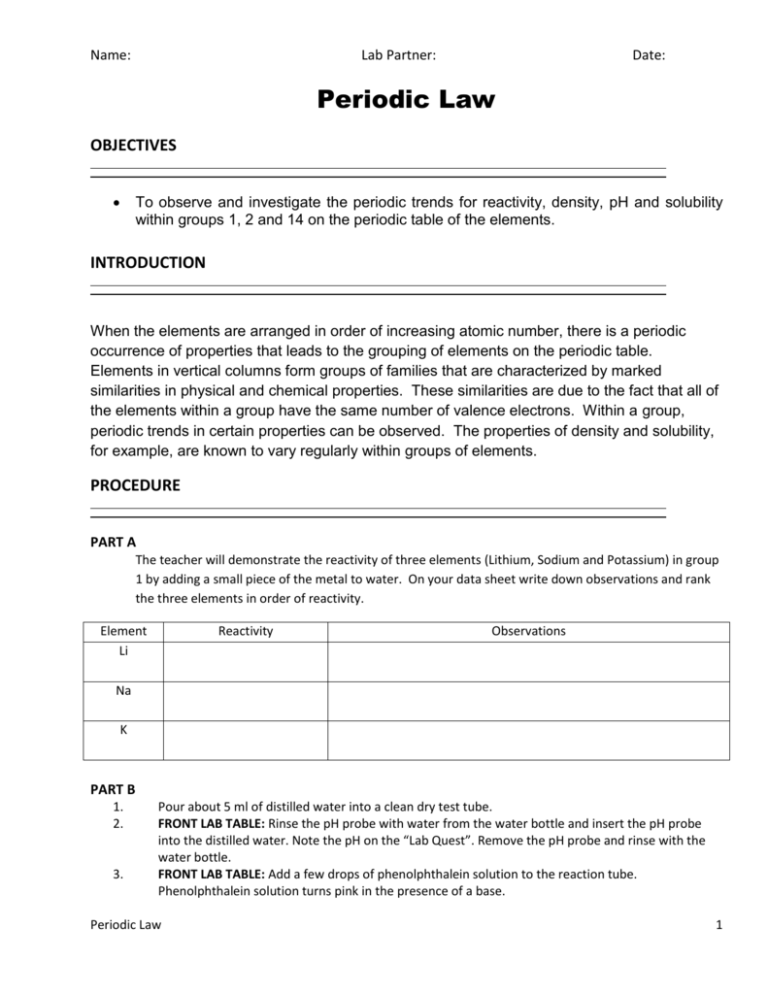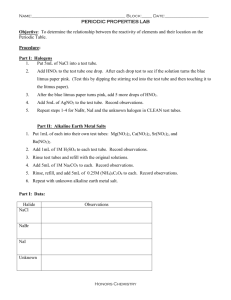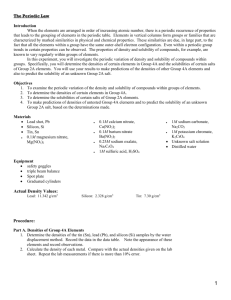Periodic Law Lab-Modified 2014
advertisement

Name: Lab Partner: Date: Periodic Law OBJECTIVES To observe and investigate the periodic trends for reactivity, density, pH and solubility within groups 1, 2 and 14 on the periodic table of the elements. INTRODUCTION When the elements are arranged in order of increasing atomic number, there is a periodic occurrence of properties that leads to the grouping of elements on the periodic table. Elements in vertical columns form groups of families that are characterized by marked similarities in physical and chemical properties. These similarities are due to the fact that all of the elements within a group have the same number of valence electrons. Within a group, periodic trends in certain properties can be observed. The properties of density and solubility, for example, are known to vary regularly within groups of elements. PROCEDURE PART A The teacher will demonstrate the reactivity of three elements (Lithium, Sodium and Potassium) in group 1 by adding a small piece of the metal to water. On your data sheet write down observations and rank the three elements in order of reactivity. Element Li Reactivity Observations Na K PART B 1. 2. 3. Pour about 5 ml of distilled water into a clean dry test tube. FRONT LAB TABLE: Rinse the pH probe with water from the water bottle and insert the pH probe into the distilled water. Note the pH on the “Lab Quest”. Remove the pH probe and rinse with the water bottle. FRONT LAB TABLE: Add a few drops of phenolphthalein solution to the reaction tube. Phenolphthalein solution turns pink in the presence of a base. Periodic Law 1 4. 5. 6. 7. 8. Add a piece of calcium to the water in the test tube. Collect the gas being released by holding an inverted test tube over the reactant tube with a test tube holder. Test for hydrogen gas by inserting a burning match into the upper part of the inverted test tube. FRONT LAB TABLE: Rinse the pH probe with water from the water bottle and insert the pH probe into the solution. Note the pH on the “Lab Quest”. Remove the pH probe. Record all of your observations on the data sheet and discard the contents of the tube and rinse thoroughly. Remove the pH probe and rinse with the water bottle. Repeat steps #1 -7. Instead of using calcium use a 5 cm piece of Mg ribbon (curled into a ball). Observe the reaction carefully. It may be necessary to watch closely for several minutes to see the reaction. Part B Element Mg Reactivity Observations Ca PART C 1. 2. Record the pH of each solution by using the “Lab Quest” pH probe. a. Calcium hydroxide Ca(OH)2 b. Magnesium hydroxide Mg(OH)2 c. Barium hydroxide Ba(OH)2 Mg(OH)2 In separate wells on your spot plate, place 5 drops of the above solutions. Record the pH of each solution by using the pH paper. Ba(OH)2 Solution pH pH Probe Paper Ca(OH)2 PART D 1. 2. 3. Determine the densities of the carbon, tin, lead and silicon samples provided by measuring their mass with a balance and determining their volume by water displacement. Use your rules of significant measurements. Record your data on the data sheet along with observations of the physical characteristics of each element. Make a graph of density vs. period number for each element in the family. Include the required elements of a graph. Element C Mass (g) Vfinal (ml) Vinitial (ml) Volume (ml) Density equation Density Si Sn Pb Periodic Law 2 PART E 1. 2. 3. 4. 5. Use two clean spot plates set up side by side (just like in figure below). Add 5 drops of each of the nitrates to each well in the first four columns. Add 5 drops of H2SO4 to the wells in the first column, 5 drops of Na2CO3 to the wells in the second column, (NH4)2C2O4 to the wells in the third column and 5 drops of K2CrO4 to the wells in the fourth column. The last row is not being used. Observe the solubility of each reaction. If the product of the reaction is insoluble a precipitate will be formed. Evidence of a precipitate is the formation of a solid in an aqueous solution. It will appear cloudy or foggy. Record the solubility of each reaction in your data table. (S = soluble, I = insoluble) H2SO4 (NH4)2C2O4 H2SO4 Na2CO3 (NH4)2C2O4 K2CrO4 Mg(NO3)2 Ca(NO3)2 Sr(NO3)2 Ba(NO3)2 Mg(NO3)2 Ca(NO3)2 Sr(NO3)2 Ba(NO3)2 Unknown Na2CO3 Periodic Law K2CrO4 3 PERIODIC LAW LAB REPORT Write a lab report by including the following information in your analysis. Examples from the data and your observations to support your statements. Include the correct data tables and graphs for each question. 1. A description of the reactivity of the alkali and alkaline Earth metals. Identify the most and least reactive elements and what type of trends you notice. Use your knowledge of shielding and ionization energy to help explain the reason for this trend. 2. The trend for the pH of the bases formed by alkaline Earth metals (Part C), including which element forms a base with the highest pH and which the lowest. Use your knowledge of electronegativity to help explain the reason for this trend. 3. Use your graph to describe the trend of group 14 elements and estimate the value of the density of Germanium. 4. Describe the trend of solubility for group 2 elements (Part E), indicate which element is most often soluble and which one is least often soluble. Data tables can be found on the website. Periodic Law 4






